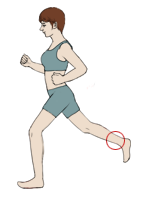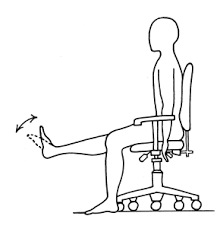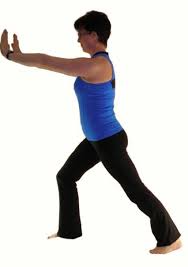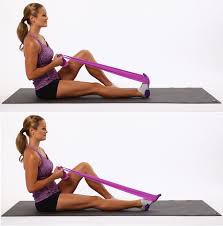 In an ideal world, the life of a runner would be free of any pain and injuries, but unfortunately, we're not living in an ideal world. No matter how hard you try, you will always find yourself dealing with certain injuries – a tight hamstring, a tender foot, or more – that will cause ankle pain when running.
In an ideal world, the life of a runner would be free of any pain and injuries, but unfortunately, we're not living in an ideal world. No matter how hard you try, you will always find yourself dealing with certain injuries – a tight hamstring, a tender foot, or more – that will cause ankle pain when running.
It happens because your knee, ankle, and hip provide you with the propulsive force you need while running. It also implies that a healthy ankle joint will play a big role in preventing other injuries. Still, you may experience ankle pain after running mainly due to issues like Achilles tendinitis, inversion sprain, and blisters. You need to know what's causing ankle pain running to be able to find an appropriate treatment option.
What Causes Ankle Pain When Running?
Your sore ankles may be due to arthritis, tight muscles, muscle strains, tendinitis, or minor ankle sprains. Here are some of the main causes of ankle pain while running:
1. Achilles Tendinitis
It is common for runners to deal with Achilles tendinitis at one point in their running lives. The Achilles tendon is actually a fibrous tissue that binds your calcaneus bone with your calf muscles. While the tissue is quite thick and strong, you may still experience an injury due to misalignment, overuse, medication side effects, and improper footwear. The pain usually takes a while to build and become annoying. Your skin may become red and swell over time. Taking plenty of rest may help alleviate pain and swelling.
2. Ankle Sprain
While running, you may roll or twist your ankle, which sometimes tear the surrounding ligaments. The experts call it an ankle sprain and it can be extremely painful and usually makes you say goodbye to your running routine for several weeks. Resting, icing, and compressing with an Ace bandage may help improve your condition.
3. Overuse Injury
If you've just started running and you've actually increased your distance or speed too quickly, this may lead to an overuse injury caused by excessive pressure on your bones, muscles, and ligaments. Be sure to see your physician if you haven't injured your ankle but you're experiencing some pain.
4. Blisters
Wearing ill-fitting shoes will cause friction and cause blisters. You usually notice these blisters when lymph fluid fills the spaces between your outer and inner skin layers. You may experience blisters if you're participating in relatively longer distance events such as ultra-marathons, marathons, or adventure races. Even when these blisters are small, they can still be quite painful and even keep you from running for a while. Make sure to invest on good shoes that fit you well and provide protection to areas that rub against the shoe.
Note:
It is a good idea to take your running shoes with you when you pay your physician a visit. They will use it to evaluate what's causing trouble in your case. If your shoes are right, they may look for other ways to identify the problem.
How to Deal with Ankle Pain When Running
It is common to have sore ankles after running, but sometimes pain can be unbearable. It is important to do something to fix the issue, and that's when you need to know what's causing the pain in the first place. You can always start with stretching and strengthening exercises to relieve ankle soreness. Here are some other treatment options, but remember, it's a good idea to see your physician if your ankle pain from running also accompanies with swelling and redness.
1. For Severe Cases
You shouldn't be doing any stretches or regular strengthening exercises if you have severe ankle soreness. Wait until 72 hours for swelling to go away. During this time, you can use compression wrap, elevate your affected ankle, and take plenty of rest. Taking OTC medications such as acetaminophen will also help alleviate pain.
2. Relax and Rest
Sometimes, the sprain isn't that serious and responds well to rest. So, stop for a while and avoid running while you're feeling any pain in your ankle. Ice, elevation, and compression will also help accelerate the healing process.
3. Ankle Circles
You have to perform this active stretch in a lying or seated position. Simple roll your ankle counterclockwise and then repeat the same in a clockwise motion. Do it for 15 times – you should do it before you start running to keep your ankle muscles flexible and to avoid ankle pain running.
4. Standing Calf Stretch
 You can perform a standing calf stretch if you feel your calf muscles a bit tight – this stretching exercise is equally beneficial for Achilles tendinitis. You should perform this stretch in a staggered stance by lunging forward while making sure the back heel is down. Keep lunging forward until you notice a stretch in your calf. Stay in that posture for 15 seconds. Repeat thrice.
You can perform a standing calf stretch if you feel your calf muscles a bit tight – this stretching exercise is equally beneficial for Achilles tendinitis. You should perform this stretch in a staggered stance by lunging forward while making sure the back heel is down. Keep lunging forward until you notice a stretch in your calf. Stay in that posture for 15 seconds. Repeat thrice.
5. Resistance Band
 Use a resistance band to strengthen your ankle muscles. You have to wrap one of a four-way resistance band around your foot and attach the other end to any stable object. Keep your leg straight and start moving your ankle in extension, flexion, inversion, or adduction. Repeat thrice with each set consisting of 10 reps.
Use a resistance band to strengthen your ankle muscles. You have to wrap one of a four-way resistance band around your foot and attach the other end to any stable object. Keep your leg straight and start moving your ankle in extension, flexion, inversion, or adduction. Repeat thrice with each set consisting of 10 reps.
The video shows some massage tips and stretch moves to relieve ankle pain:
Prevent Recurrent Injuries
If you have already experienced an injury and have just healed it, be sure to start carefully. In fact, it is a good idea to wear a tape or brace to avoid getting another ankle pain running injury.
Choosing Right Shoes
Make no compromises over the quality of your running shoes. Anything less than perfect will lead to serious injury. Ensure that your shoes provide support under the arch as well as in the front, especially if you have low arches. Also, ensure that the heel counter of your shoes is very stable. People with high arches should select a pair of shoes with softer platform. Instead of buying cross training shoes, you will be better off investing on sport-specific shoes.
Be Careful When Running Uphill
It is true that running uphill is an outstanding workout, but it is important that you increase the distance gradually or else it will lead to serious foot and ankle injuries.
